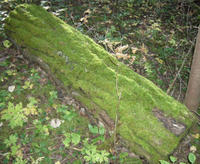When I left for my vacation on September 23, the leaves were golden and red and those that had fallen were crunchy under your feet. As I traveled west, returning to the coast and my childhood home, I was reminded that not all places go through such dramatic colour change. Passing across the continental divide and driving through places like Salmon Arm, Hope and finally Vancouver, I found that fall hadn't quite arrived. Deciduous trees in my parents' neighbourhood were still green; just about to change. Lawns were still lush. There was no crunch, crunch, crunch, as the kids walked down the street to school.
When we left on the 9th of October to head home, things were just starting to change. Leaves were changing (to brown instead of orange, yellow and red) and some were starting to fall; often to form damp clumps in the ditches and gutters. Back home in Alberta I found I was happy to see a nice thick coating of brittle leaves from the paper birch in our front yard. All the trees are well on their way to becoming bare and in fact most are now looking nicely ready for winter: Naked branches contrast on bright blue skies. This is the autumn I never had as a kid. I like living in a place that has four definite seasons - even if one of them is blindingly cold.
The onset of a change in seasons has brought about a change in staff as well. Jo-Anne has obtained full-time work with a local properties management company and will be leaving her daytime interpretive work behind her. She will remain with us for weekend and evening programs and visitor services shifts. We wish Jo-Anne the best of luck in her new field. Joining us is Caroline. This transplanted American comes to us fresh from completing her degree in Environmental Policy and an internship at the
Thomas Irving Dodge Nature Centre in Minnesota. Welcome aboard Carrie.
For those of you living in Central Alberta, there are still spaces available for Jo-Anne's
Winter Camping program on October 22. Call the Nature Centre at 346-2010 or email us for more information.

 The Tuesday morning Nature Nursery kids had their Halloween party this week. Spooky games and snacks, costumed kids and a candy-filled, pumpkin-shaped pinata that just wouldn't break.
The Tuesday morning Nature Nursery kids had their Halloween party this week. Spooky games and snacks, costumed kids and a candy-filled, pumpkin-shaped pinata that just wouldn't break.
 I have to admit that one of my favourite parts of the Sanctuary is the dark forest in the shadow of Michener Hill. Its almost mountain-like feel is a reminder that Red Deer exists in the middle of a real traffic jam of plant communities. In a fairly small area you can find everything from marsh and grassland to full spruce forest.
I have to admit that one of my favourite parts of the Sanctuary is the dark forest in the shadow of Michener Hill. Its almost mountain-like feel is a reminder that Red Deer exists in the middle of a real traffic jam of plant communities. In a fairly small area you can find everything from marsh and grassland to full spruce forest.